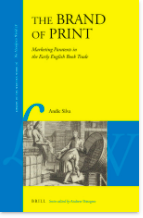Monograph

The Brand of Print: Marketing Paratexts in the Early English Book Trade. Leiden: Brill, 2019.
This book offers a comprehensive analysis of the ways printers, publishers, stationers, and booksellers designed paratexts to market printed books as cultural commodities. Tracing envoys to the reader, visual design in title pages and tables of contents, and patron dedications, this study how the agents of print branded their markets by crafting relationships with readers and articulating the value of their labor in an increasingly competitive trade. The Brand of Print encourages a consideration of how print agents’ labor and agency, made visible through paratextual design, continues to influence how we read, study, and digitize early modern texts.
Journal Articles and Book Chapters
“Remixing the Canon: Shakespeare, Popular Culture, and the Undergraduate Editor.” Forthcoming in New Technologies in Medieval and Renaissance Studies series (Iter Press), Forthcoming December 2022.
“‘Framed and clothed with variety’: Print Culture, Multimodality, and Visual Design in John Derricke’s Image of Ireland.” John Derricke’s Image of Irelande: Work and Contexts. Eds. Herron, Iammarino, Moroney. Manchester University Press (2021).
“Corrections.” Archbook: Architectures of the Book. 2017.
“Counterfeit Letters and Fictional Trials: Thomas More’s Utopia as Cultural Brand.” Appositions 9 (2016).
“Mediated Technologies: Locating Non-Authorial Agency in Printed and Digital Texts.” History of European Ideas 42.5 (2016), 607-617.
“Digital Literacies and Visual Rhetoric: Scaffolding a Meme-Based Assignment Sequence for Introductory Composition Classes.” Journal of Interactive Technology and Pedagogy (2016).
Co-authored articles
“A Conversation Rewound: Queer and Racialised Temporalities in Hamilton.” Studies in Musical Theatre 12.2 (2018): 265-73. Co-authored with Shereen Inayatulla.
“Storing and Accessing Knowledge: Digital Tools for the Study of Early Modern Drama.” Co-authored with Laura Estill. Shakespeare’s Language in Digital Media: Old Words, New Tools. Edited by Jennifer Roberts-Smith and Janelle Jenstad. Abingdon, England: Routledge, 2017. 131-144.
“Who Tells Our Story: Intersectional Temporalities in Hamilton, An American Musical.” Changing English: Studies in Culture and Education 24.2 (2017): 190-201. Co-authored with Shereen Inayatulla.
Reviews
“Fleuron: A Database Eighteenth-Century Printers’ Ornaments.” Early Modern Digital Review. Forthcoming.
“Shakespeare and the Book Trade.” Sixteenth Century Journal XLV.4 (Winter 2014), 1057-8.
“Early Modern Studies After the Digital Turn.” Papers of the Bibliographical Society of America 112.2 (2018): 270-4.
“Tamburlaine the Great at the Theater for a New Audience.” Early Modern Literary Studies 18.2 (2015).
“Shakespeare in the Park’s Cymbeline.” Cahiers Elisabethains 88 (Autumn 2015).
Web-based Publications
“Commonplace Book Assignment.” Tactics for Teaching a Diverse Past. Boyda Johnstone and Matthew Harrison, eds. https://medievalhighered.omeka.net/items/show/47
“Why Watch Taming of the Shrew?: On Enduring, Witnessing, and the Comedy of Domestic Violence.” Professional Website. http://andiesilva.net/blog/why-watch-taming-of-the-shrew-on-enduring-witnessing-and-the-comedy-of-domestic-violence/
“Great Lakes THATCamp Review: Community, Student Engagement, and Digital Resources.” Gale Morris Sweetland Digital Rhetoric Collaborative http://bit.ly/GLThatCampReview
“New Databases and Digitization Projects Parts I and II,” Early Modern Online Bibliography. http://bit.ly/NewDigitalProjects and http://bit.ly/NewDigitalProjects2
“Are You a Digital Humanist?” Professional Website. http://andiesilva.net/blog/are-you-a-digital-humanist/


